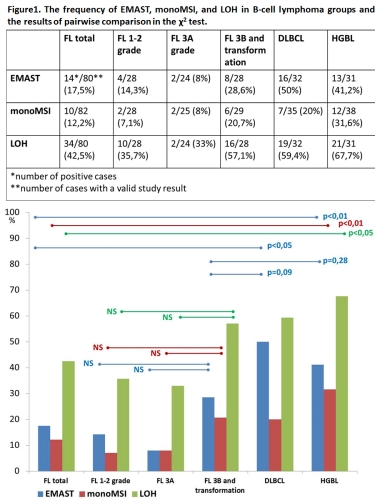
Contributions
Abstract: EP884
Type: E-Poster Presentation
Session title: Lymphoma Biology & Translational Research
Background
Identification of patients with an unfavorable course of B-cell lymphomas could be difficult at the disease onset. The existing risk stratification models are based mainly on the patient somatic status and disease clinical features. The evidence suggests that it is necessary to search for new markers that would reflect the pathogenesis and behavior of the particular tumor.
DNA repair system functions to preserve the original sequence. The role of mismatch repair system (MMR) deficiency and the resulting microsatellite repeats instability (MSI) has been proven for solid tumors, in particular, colorectal cancer. As B-cell tumors are characterized by high genetic plasticity we suggest that their pathogenesis may also involve changes in the repair system.
Aims
To analyze microsatellite changes associated with repair system deficiency in patients with aggressive and indolent B-cell lymphomas.
Methods
Thirty-five diffuse large B-cell lymphoma (DLBCL) patients, 38 high-grade B-cell lymphoma (HGBL) patients, and 84 follicular lymphoma (FL) patients were included. There were 28 1-2 grade FL patients, 25 3A grade FL patients, and 31 patients with type 3B FL and the transformation of FL into large-cell lymphoma in the latter group. All patients gave their voluntary consent to participate in the study. Microsatellite instability was studied using COrDIS Plus and COrDIS MSI kits (Gordiz Ltd, Russia) in tumor tissue and in peripheral blood cells as a control sample. Amplification was performed using thermal cycler DNAEngine (BioRad, USA). The subsequent fragment analysis was performed on the genetic analyzer Nanofor-05 (Sintol Ltd, Russia).
Results
The detected changes in the microsatellite profile were classified as follows: EMAST (elevated microsatellite alterations at selected tetranucleotide repeats) – the appearance of a new allele of tetranucleotide loci; LOH (loss of heterozygosity) – allelic imbalance; monoMSI – aberrations of mononucleotide markers that could not be differentiated between LOH and instability. Data on these genetic alterations frequencies and results of χ2 test are shown in Figure 1.
In general, DLBCL and HGBL are more likely to have microsatellite aberrations, especially EMAST, than FL. Microsatellite aberrations frequencies in DLBCL and HGBL groups were comparative. Within the general group of FL, differences were observed between indolent (1-2 and 3A grades) and aggressive FL (3B and FL transformation), but they did not reach statistical significance. However, EMAST, monoMSI, and LOH frequencies in transformed FL are seemed higher than in indolent FL.
The aggressive FL group is intermediate between DLBCL and HGBL and indolent FL. It is important to note that the histological transformation of FL does not accumulate a significant number of microsatellite aberrations in the genome, not like aggressive B-cell lymphomas de novo. This indicates that microsatellite repeats instability is mostly the tumor feature at its early development stages and is not acquired during tumor progression.

Conclusion
Microsatellite instability is common in B-cell lymphomas. EMAST, monoMSI, and LOH distribution have no nosological specificity. These genetic alterations are more peculiar to aggressive lymphomas de novo. The lack of statistical significance in pairwise comparison does not allow considering microsatellite analysis as a differential diagnosis tool. However, the probable prognostic significance of EMAST, monoMSI, or LOH could be reached while expanding the cohort of patients and conducting additional survival analysis.
Keyword(s): DNA damage, Follicular lymphoma, High-grade non-Hodgkins-lymphoma, Mutation analysis
Abstract: EP884
Type: E-Poster Presentation
Session title: Lymphoma Biology & Translational Research
Background
Identification of patients with an unfavorable course of B-cell lymphomas could be difficult at the disease onset. The existing risk stratification models are based mainly on the patient somatic status and disease clinical features. The evidence suggests that it is necessary to search for new markers that would reflect the pathogenesis and behavior of the particular tumor.
DNA repair system functions to preserve the original sequence. The role of mismatch repair system (MMR) deficiency and the resulting microsatellite repeats instability (MSI) has been proven for solid tumors, in particular, colorectal cancer. As B-cell tumors are characterized by high genetic plasticity we suggest that their pathogenesis may also involve changes in the repair system.
Aims
To analyze microsatellite changes associated with repair system deficiency in patients with aggressive and indolent B-cell lymphomas.
Methods
Thirty-five diffuse large B-cell lymphoma (DLBCL) patients, 38 high-grade B-cell lymphoma (HGBL) patients, and 84 follicular lymphoma (FL) patients were included. There were 28 1-2 grade FL patients, 25 3A grade FL patients, and 31 patients with type 3B FL and the transformation of FL into large-cell lymphoma in the latter group. All patients gave their voluntary consent to participate in the study. Microsatellite instability was studied using COrDIS Plus and COrDIS MSI kits (Gordiz Ltd, Russia) in tumor tissue and in peripheral blood cells as a control sample. Amplification was performed using thermal cycler DNAEngine (BioRad, USA). The subsequent fragment analysis was performed on the genetic analyzer Nanofor-05 (Sintol Ltd, Russia).
Results
The detected changes in the microsatellite profile were classified as follows: EMAST (elevated microsatellite alterations at selected tetranucleotide repeats) – the appearance of a new allele of tetranucleotide loci; LOH (loss of heterozygosity) – allelic imbalance; monoMSI – aberrations of mononucleotide markers that could not be differentiated between LOH and instability. Data on these genetic alterations frequencies and results of χ2 test are shown in Figure 1.
In general, DLBCL and HGBL are more likely to have microsatellite aberrations, especially EMAST, than FL. Microsatellite aberrations frequencies in DLBCL and HGBL groups were comparative. Within the general group of FL, differences were observed between indolent (1-2 and 3A grades) and aggressive FL (3B and FL transformation), but they did not reach statistical significance. However, EMAST, monoMSI, and LOH frequencies in transformed FL are seemed higher than in indolent FL.
The aggressive FL group is intermediate between DLBCL and HGBL and indolent FL. It is important to note that the histological transformation of FL does not accumulate a significant number of microsatellite aberrations in the genome, not like aggressive B-cell lymphomas de novo. This indicates that microsatellite repeats instability is mostly the tumor feature at its early development stages and is not acquired during tumor progression.

Conclusion
Microsatellite instability is common in B-cell lymphomas. EMAST, monoMSI, and LOH distribution have no nosological specificity. These genetic alterations are more peculiar to aggressive lymphomas de novo. The lack of statistical significance in pairwise comparison does not allow considering microsatellite analysis as a differential diagnosis tool. However, the probable prognostic significance of EMAST, monoMSI, or LOH could be reached while expanding the cohort of patients and conducting additional survival analysis.
Keyword(s): DNA damage, Follicular lymphoma, High-grade non-Hodgkins-lymphoma, Mutation analysis


